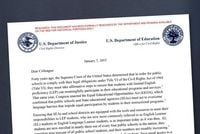The Trump administration has set off a fierce debate over language, equity, and education policy in the United States by quietly rescinding a longstanding federal guidance that directed public schools to support students learning English. This move, reported by multiple outlets including The Washington Post, Straight Arrow News (SAN), and The Times of India, has alarmed education advocates and left millions of families and teachers uncertain about the future of English language instruction in American schools.
At the heart of the controversy is a 2015 guidance document issued by the Department of Education and the Department of Justice. That 40-page document, rooted in decades of Supreme Court rulings and federal civil rights law, laid out how schools should comply with Title VI of the Civil Rights Act of 1964. Title VI bars discrimination based on national origin, and courts have long interpreted this to mean that schools must provide support services to students who are not yet proficient in English. According to The Times of India, this legal framework has been in place for nearly 50 years, bolstered by landmark cases such as Lau v. Nichols (1974) and the Equal Educational Opportunities Act of the same year.
But as of August 2025, that guidance has been rescinded. The decision follows a series of sweeping policy changes by President Donald Trump, who on March 1 signed an executive order declaring English the official language of the United States. The order revoked a Clinton-era mandate that had expanded translation and interpretation services for people with limited English proficiency. It also directed federal agencies to scale back multilingual services, phase out unnecessary multilingual materials, and clarify that English is the authoritative version of federal documents (Straight Arrow News).
"If, in fact, we want our students to learn English, this needs to be in place," said Montserrat Garibay, who led the Office of English Language Acquisition under the Biden administration, in comments to The Washington Post. She described the 2015 guidance as "kind of like the Bible" for teachers working with English learners. Garibay added, "Instead of providing this office with more capacity and more resources to do exactly what the executive order says — to make sure that everybody speaks English — they are doing the total opposite."
The rescission of the guidance is just one part of a broader shift. Since taking office, the Trump administration has prioritized English-speaking as a national priority while cutting support for roughly 5 million U.S. public school students classified as English learners. In February 2025, the administration laid off nearly all workers in the Department of Education's Office of English Language Acquisition and called for the elimination of nearly $890 million in federal funding for English language learning programs (The Washington Post).
Julie Sugarman, associate director for K-12 education research at the Migration Policy Institute, told Straight Arrow News that while the guidance was never codified into law, it served as an important marker for how federal agencies evaluated schools' compliance with civil rights protections. "I think there’s going to be states that continue to press forward and use an equity focus to develop policies and practices. And then there’s states that are going to say, you know, we really feel like we’re being allowed, you know, to not provide these services," Sugarman said. She warned that schools less committed to supporting English learners might feel emboldened to scale back services in the absence of federal oversight.
The Justice Department, led by Attorney General Pam Bondi, has defended the policy shift. In a July 2025 memo to all federal agencies, the DOJ argued that treating people differently based on English proficiency "does not on its face amount to discrimination based on national origin." The memo outlined plans to "minimize non-essential multilingual services" and to issue new government-wide guidelines by January 2026 to help agencies prioritize English while clarifying when multilingual assistance remains necessary. Bondi described the effort as a push to "promote assimilation over division," as reported by The Washington Post.
Not everyone opposes the move. Supporters of stricter immigration and language policies argue that removing pressure on schools to provide extensive multilingual services allows them to focus resources more efficiently. Ira Mehlman, spokesman for the Federation for American Immigration Reform, told The Washington Post, "If you devote all these resources to these kids coming in completely unprepared, inevitably it will diminish the quality of education others are getting." Todd DuBois of US English added that multilingual instruction can "get in the way of teaching English literacy earlier in life."
However, many education advocates and civil rights groups see the rescission as a dangerous retreat from decades of progress. Michael Pillera, an attorney and director of the Educational Opportunities Project at the Lawyers Committee for Civil Rights, said, "The Department of Education and the Department of Justice are walking away from 55 years of legal understanding and enforcement. I don’t think we can understate how important that is," according to The Washington Post. Leslie Villegas, an education policy analyst at New America, warned that "the rescission of this guidance may create the mentality that no one’s watching," a concern that could have immediate consequences for school districts facing compliance or financial pressures.
The effects of the policy change are already being felt beyond the classroom. The Department of Housing and Urban Development (HUD), for example, announced in August 2025 that it would provide services and communications exclusively in English, eliminating non-English materials except where required by law. Housing Secretary Scott Turner declared on social media, "HUD is ENGLISH only," and Deputy Secretary Andrew Hughes confirmed the change in a memo, noting that HUD previously offered services in more than 200 languages (Straight Arrow News).
In education, the Justice Department has released at least three school districts—Boston, Newark, and Worcester, Massachusetts—from federal monitoring of English-language programs, signaling a further reduction in oversight. The Education Department, for its part, stated that the 2015 guidance was rescinded because it "is not in line with Administration policy," according to spokeswoman Madi Biedermann (The Times of India).
For the more than 5 million English learners in U.S. public schools, the future is now clouded by uncertainty. While some states and districts may continue to support English learners out of a sense of equity and best practice, others may feel little incentive to maintain or expand services without federal guidance or enforcement. As Sugarman put it, "Schools committed to best practices and student success are likely to continue supporting English learners despite the changes." But for many students and educators, the lack of clear federal standards could mean navigating their education in uncharted waters.
This shift in federal policy marks a profound change in how the United States approaches language and inclusion in public institutions. Whether it will foster greater unity or deepen existing divides remains to be seen, but for now, the nation’s English learners and their advocates are left watching, waiting, and hoping their voices will not be lost in translation.





